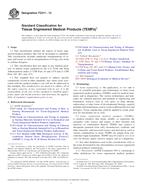Potřebujeme váš souhlas k využití jednotlivých dat, aby se vám mimo jiné mohly ukazovat informace týkající se vašich zájmů. Souhlas udělíte kliknutím na tlačítko „OK“.
ASTM F2952-14
Standard Guide for Determining the Mean Darcy Permeability Coefficient for a Porous Tissue Scaffold
Automaticky přeložený název:
Standardní Guide pro určení Mean Darcy koeficient propustnosti pro porézní tkáně lešení
NORMA vydána dne 1.3.2014
Informace o normě:
Označení normy: ASTM F2952-14
Poznámka: NEPLATNÁ
Datum vydání normy: 1.3.2014
Kód zboží: NS-54781
Počet stran: 7
Přibližná hmotnost: 21 g (0.05 liber)
Země: Americká technická norma
Kategorie: Technické normy ASTM
Kategorie - podobné normy:
Anotace textu normy ASTM F2952-14 :
Keywords:
ICS Number Code 11.100.99 (Other standards related to laboratory medicine)
Doplňující informace
| Significance and Use | ||||||||
|
4.1 This document describes the basic principles that need to be followed to obtain a mean value of the Darcy permeability coefficient for structures that consist of a series of interconnected voids or pores. The coefficient is a measure of the permeability of the structure to fluid flowing through it that is driven by a pressure gradient created across it. 4.2 The technique is not sensitive to the presence of closed or blind-end pores (Fig. 1 ).4.3 Values of the permeability coefficient can be used to compare the consistency of manufactured samples or to determine what the effect of changing one or more manufacturing settings has on permeability. They can also be used to assess the homogeneity and anisotropy of tissue scaffolds. Variability in the permeability coefficient can be also be indicative of: 4.3.1 Internal damage within the sample e.g., cracking or permanent deformation. 4.3.2 The presence of large voids, including trapped air bubbles, within the structure. 4.3.3 Surface effects such as a skin formed during manufacture. 4.3.4 Variable sample geometry. 4.4 This test method is based on the assumption that the flow rate through a given sample subjected to an applied pressure gradient is constant with time. 4.5 Care should be taken to ensure
that hydrophobic materials are fully wetted out when using water or
other aqueous-based liquids as permeants.
4.6 Conventionally, the pressure differential created across a sample is measured as a function of both increasing and decreasing flow rates. An alternative approach, which may be practically easier to create, is to apply a range of different pressure differentials across the sample and measure the resultant flow of fluid through it. The hysteresis that occurs during a complete cycle of increasing flow rate followed by a progressive decrease in flow rate can provide an excellent measure of the behavioural consistency of the matrix. Significant hysteresis in the measured pressure differential during increasing and decreasing flow rates can indicate the existence of induced damage in the structure, the fact that the material is behaving viscoelastically or suffering from permanent plastic deformation. Some guidance on how to identify which of these factors are responsible for hysteresis is provided in Section 7. 4.7 It is assumed that Darcy’s law is valid. This can be established by plotting the volume flow through the specimen against the differential pressure drop across the specimen. This plot should be linear for Darcy’s law to apply and a least squares fit to the data should pass through the origin. It is not uncommon for such plots to be non-linear which may indicate that the structure does not obey Darcy’s law or that the range of pressures applied is too broad. This topic is further discussed in Section 1.1 This guide describes test methods suitable for determining the mean Darcy permeability coefficient for a porous tissue scaffold, which is a measure of the rate at which a fluid, typically air or water, flows through it in response to an applied pressure gradient. This information can be used to optimize the structure of tissue scaffolds, to develop a consistent manufacturing process, and for quality assurance purposes. 1.2 The method is generally non-destructive and non-contaminating. 1.3 The method is not suitable for structures that are easily deformed or damaged. Some experimentation is usually required to assess the suitability of permeability testing for a particular material/structure and to optimize the experimental conditions. 1.4 Measures of permeability should not be considered as definitive metrics of the structure of porous tissue scaffolds and should complement measures obtained by other investigative techniques e.g., scanning electron microscopy, gas flow porometry and micro-computer x-ray tomography (ASTM F2450). 1.5 This standard does not purport to address all of the safety concerns, if any, associated with its use. It is the responsibility of the user of this standard to establish appropriate safety and health practices and determine the applicability of regulatory limitations prior to use. |
||||||||
| 2. Referenced Documents | ||||||||
|
Podobné normy:
Historická
1.10.2013
Historická
1.3.2011
Historická
1.3.2012
Historická
1.2.2013
Historická
15.10.2010
Historická
1.12.2011



 ASTM F2211-13
ASTM F2211-13 ASTM F2383-11
ASTM F2383-11 ASTM F2459-12
ASTM F2459-12 ASTM F2529-13
ASTM F2529-13 ASTM F2808-10
ASTM F2808-10 ASTM F2883-11
ASTM F2883-11
 Cookies
Cookies
